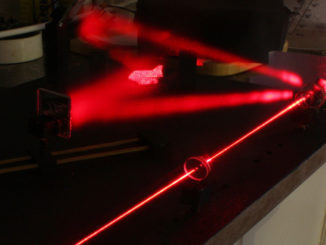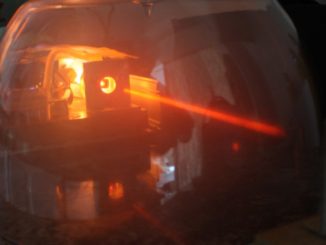
The original uploader was Bunzil at English Wikipedia., Public domain, via Wikimedia Commons
Science, like a sport, is an art that’s well practised. To lose educates you more than to win instantly. Okay, that’s corny but I’ve found that my project failures have taught me more information and are the ones that make me think. Before we look at my failure let’s consider the genius of Albert Michelson.
Albert Michelson And The Speed Of Light
Albert when asked why he studied light, he said, “because it’s so much fun.”
This was the 1880s. Lasers had not yet been invented. We’re talking paraffin lamps, arc lamps and filament lamps. The setup he used to measure the speed of light is shown below:

From this experiment Mr Michelson was clearly more nuts than the Doc! Living in California he sent a light beam on a round trip of 44 miles. Let’s examine the apparatus.
First we have a rotating octagonal mirror. This spins at a very high speed. Imagine an angle grinder on acid. We’re talking 500+ revolutions per second (RPS).
With the mirror not rotating in the position shown above, the red line is the light from a lamp. That enters a slit and through various optics bounces off of mirror (M1). This light – if all the optics are correctly aligned – returns from mirror two (M2) and, eventually, enters the small telescope (T), the blue line. The observer will see the small slit.
That’s all very clever but not much use. Now, let us spin that mirror up. Really fast. Michelson was up to 525 RPS. That’s over 31000 revolutions per minute (RPM) – remember, he was measuring the speed of light in miles per second.
If we know the distance between the two mirrors (M1, M2) and the speed of the rotating mirror then calculating the speed (or velocity) of light is easy.
The rotating mirror has eight faces. Therefore it takes one eighth of a second for the red and blue light paths to correctly realign – as it rotates – for the observer to see the light slit in the center of the telescope. If the speed of the mirror is too fast the slit will not be visible as the light traverses its 44 mile path.
Michelson found that, say, 525 revolutions per second (RPS) worked. Now all we need to do is multiply the RPS by eight and the distance the light has traveled. This turns out to be: 8 X 525 X 44 = 184800 miles per second. Pretty good!
Let’s see what the Doc can do with the speed of light.
Doc’s Light Speed Experiment
This is a simple experiment that turned out to be incalculable (with reference to the speed of light). Perhaps I should not call it a failure as it did return some interesting results. First let’s look at the setup:

In figure.1, above, the laser light passes through a spinning disc with holes drilled into it. This “chops” the light into short pulses. The motor (MT) spins the disc; its speed does not matter but the faster the better. The photo, below, shows the “choppy” wheel:

The pulsed light passes through and bounces off of a beam splitter (S). Some of this light is ‘seen’ by photo diode one (PD1). This is the reference signal. The other beam bounces off the measurement mirror (RM) and is focused onto the second photo diode (PD2). If there’s a time discrepancy between the signals from the two diodes we could (at least) prove that light ‘travels’. Here are the actual electronics:

Both signals from the PIN photo diodes were fed into my trusty old TEC-Scope. I first set the return mirror (M) in the position above. Both signals were pretty much in sync. Now look what happens when I moved the mirror 15 feet away (a round trip of 30 feet):

I’ve marked the ‘rising’ and ‘falling’ edges (in red) of both photo diodes. You can see that there is a time discrepancy between the two signals (top PD1, bottom PD2). The speed of light? Maybe not, but an interesting experiment.
Conclusion
Modern electronics, physics, Einstein’s relativity and his most famous equation need to know the speed of light. Perhaps I’ll try a high speed pulsed laser diode instead of a rotating disc. Overall a very entertaining project – even if it did not quite work.
On a lighter note, here is my new Trilby hat:

It’s only a cheap version. Granddad always wore one. Warm in the cooler months with a balding head!
Hope you all drank too much ethanol over Christmas, had plenty of family arguments and ate too much. I wish you all the best for the rest of the year.
© text & images unless otherwise indicated Doc Mike Finnley 2023



